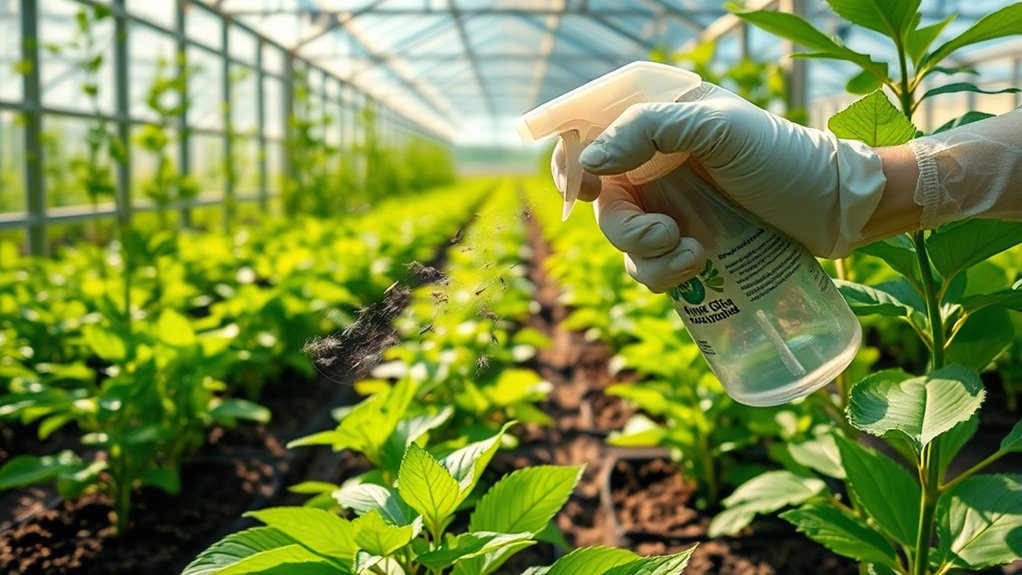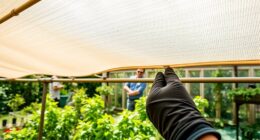To keep your greenhouse pest-free from whiteflies, start by inspecting new plants and quarantining any infested ones. Maintain cleanliness and use insect screens to keep them out. Manage populations with organic options like neem oil, or introduce beneficial insects for biological control. Chemical methods can be used if necessary, but rotate them to prevent resistance. Finally, consider companion planting to repel whiteflies and promote a healthier environment. More useful strategies await you.
Key Takeaways
- Inspect and quarantine new plants to prevent whitefly introduction into your greenhouse.
- Implement insect screens and maintain cleanliness to deter whitefly infestations.
- Utilize yellow sticky traps for effective monitoring and early detection of whiteflies.
- Apply organic control methods like neem oil and insecticidal soap to manage whitefly populations.
- Introduce beneficial insects to enhance biological control and maintain ecological balance in the greenhouse.
Understanding Whiteflies: Identification and Lifecycle

Whiteflies are pesky pests that can wreak havoc on your garden. To identify them, look for small insects, about 1/16 to 1/10 inch, with powdery white wings and yellowish bodies. Different species, like greenhouse and sweetpotato whiteflies, have unique wing patterns and postures.
They go through several lifecycle stages, starting with tiny, spindle-shaped eggs laid on leaf undersides. Once hatched, nymphs resemble small scales and progress through four immobile stages before becoming adults.
These adults emerge ready to feed on plant sap, leading to yellowing leaves and reduced plant yields. Understanding their lifecycle is essential for effective control, ensuring your plants stay healthy and productive.
Preventing Whitefly Infestations
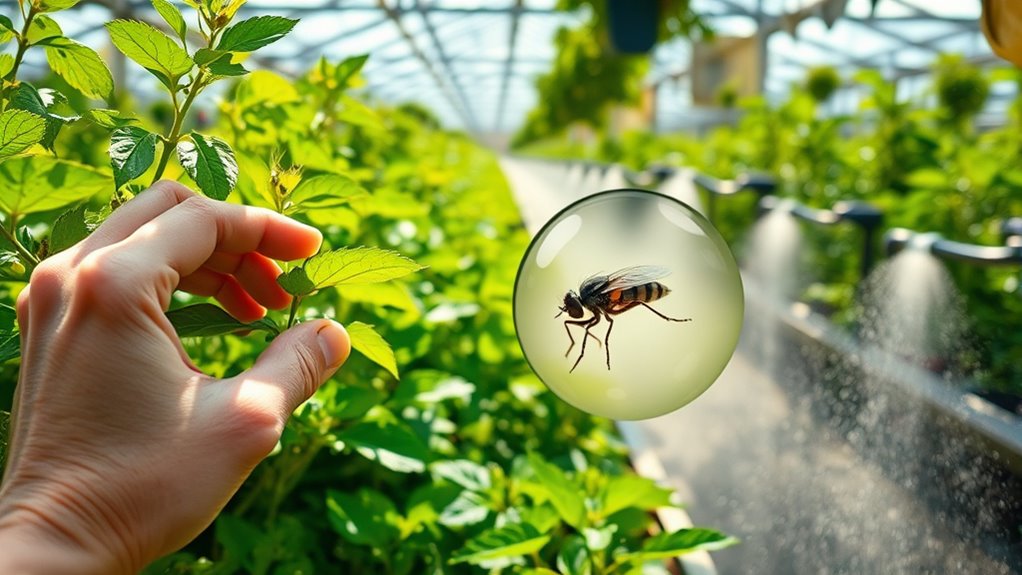
To keep your garden healthy and free from whitefly infestations, it's vital to take proactive measures before introducing new plants.
Start by carefully inspecting each plant for whiteflies. If you spot any, quarantine the plants to avoid spreading pests to your greenhouse. Additionally, eliminate weeds around your greenhouse, as they can harbor whiteflies.
Install insect screens with small holes to keep these pests out.
Maintaining cleanliness is important; confirm your greenhouse is free of debris that can attract whiteflies.
Optimize your greenhouse's climate by regulating temperature and humidity, which discourages whitefly proliferation.
Finally, choose plant varieties that are resistant to whiteflies and frequently inspect your plants for early signs of any infestation.
Organic Control Methods for Whiteflies
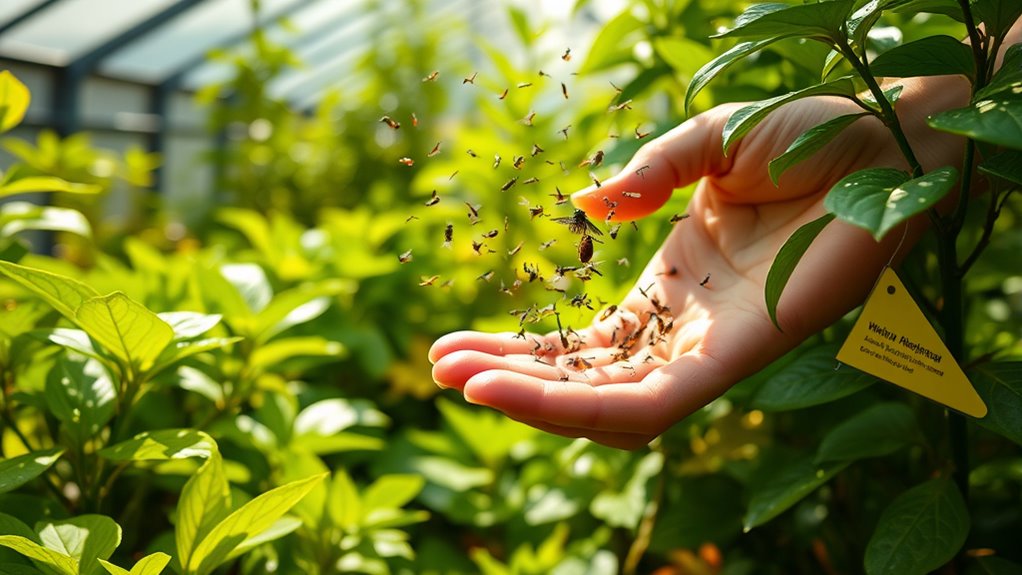
While managing whitefly populations can be challenging, utilizing organic control methods offers effective solutions that are safe for your garden and the environment.
Start by applying horticultural oils or neem oil to smother eggs and nymphs, while insecticidal soap provides another organic option, albeit with variable effectiveness.
Consider using natural pyrethrins against adult whiteflies. For physical control, vacuuming and blasting plants with water can help dislodge these pests.
Yellow sticky traps effectively capture adults and can be easily made at home. Incorporate companion planting with marigolds or basil to repel whiteflies.
Finally, maintaining ideal temperature and humidity levels can deter infestations, making your greenhouse a less inviting environment for these pesky invaders.
Biological Control Options
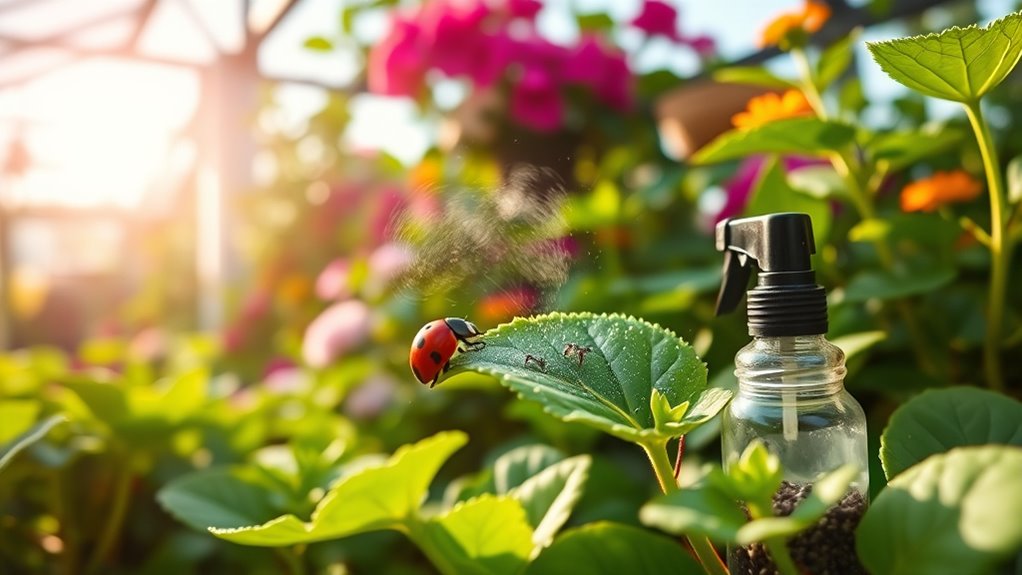
When managing whitefly infestations, considering biological control options can be a game changer for your garden. You can introduce parasitic wasps like *Encarsia formosa* and *Eretmocerus eremicus*, which target whitefly nymphs.
Predatory mites such as *Amblyseius swirskii* feed on their eggs and nymphs, while *Macrolophus pygmaeus* can consume numerous whitefly eggs daily.
Additionally, entomopathogenic fungi like *Isaria fumosoroseus* infect and kill whiteflies. For best results, release these agents early in your production cycle.
Make sure to maintain ideal environmental conditions and conduct quality checks on the agents. Regular monitoring will help you assess their effectiveness and adjust your strategies accordingly, ensuring a pest-free greenhouse.
Chemical Control Methods
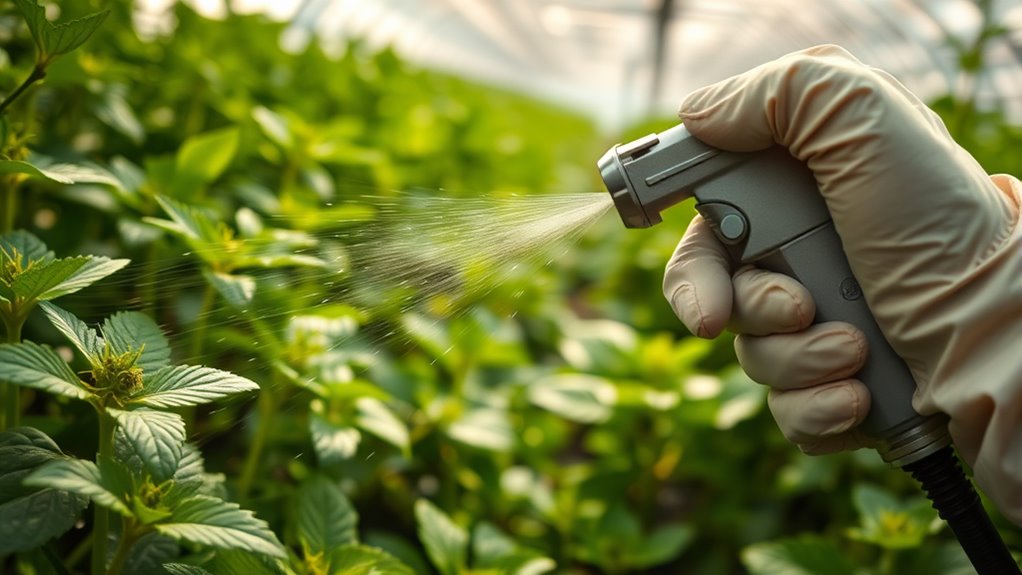
How can you effectively manage whitefly populations in your garden?
Chemical control methods can help. Systemic insecticides like neonicotinoids are particularly effective, especially on healthy plants during their active growth.
You'll want to apply these chemicals as foliar treatments or systemic applications, targeting both adult and nymph stages of whiteflies. Remember to follow all label instructions for safe use and consider crop compatibility.
Using insect growth regulators early in the cropping cycle can be beneficial, while horticultural oils and insecticidal soaps offer safer alternatives.
Keep in mind that frequent applications might be necessary, but be cautious of resistance development and the potential impact on beneficial insects.
Combining these methods with other control strategies enhances overall effectiveness.
Monitoring Whitefly Populations
Effective monitoring is essential for managing whitefly populations in your garden. Start by using yellow sticky cards, placing them vertically near plant growth and entry points like doors and vents.
Incorporate LED traps to enhance your monitoring efforts, especially for crops like tomatoes. Conduct weekly inspections to spot early infestations by checking for yellowing leaves or honeydew. Don't forget to replace traps weekly for peak effectiveness.
Randomly sample leaves from different heights to assess population density, and monitor environmental conditions like temperature and light, as these affect whitefly behavior.
Importance of Cleanliness in Greenhouses
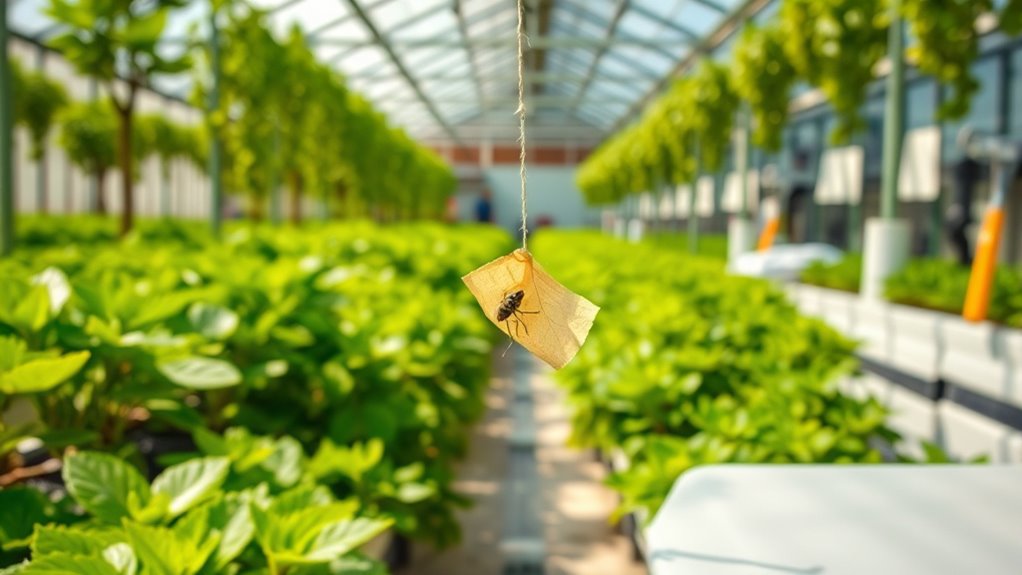
Maintaining cleanliness in your greenhouse is vital for preventing the spread of pests and diseases. Pathogens can linger in organic matter, plant debris, and on surfaces, making regular cleaning important.
By removing weeds and unhealthy plants, you reduce potential hosts for pests like whiteflies. Clean surfaces with soap and water, and consider using commercial sanitizers for a thorough clean.
Remember to empty and sanitize your greenhouse between crop cycles to avoid disease carryover. Power wash structures and verify all tools and equipment are disinfected.
Implementing footbaths at entrances encourages hygiene and protects your crops. By prioritizing cleanliness, you not only safeguard your plants but also enhance the effectiveness of your pest management strategies. Additionally, maintaining community resilience through shared knowledge about pest control can significantly improve overall greenhouse health.
Climate Control Strategies

To effectively manage whitefly populations in your greenhouse, implementing climate control strategies is crucial.
Start by maintaining a consistent temperature, as whiteflies thrive in warmth. Keep humidity levels low to create an unfavorable environment for these pests.
Maintaining a steady temperature and low humidity is key to creating an inhospitable environment for whiteflies.
Make sure proper ventilation to prevent them from entering through open doors and vents. Installing screens can further block their access.
During warmer seasons, increase your vigilance, as whiteflies are more active then.
Consider greenhouse design features like double-door entries and insulated walls to enhance climate control.
Finally, make sure good air circulation to reduce humidity and disrupt whitefly life cycles.
These strategies work together to create a less inviting habitat for whiteflies and protect your plants.
Companion Planting for Pest Management
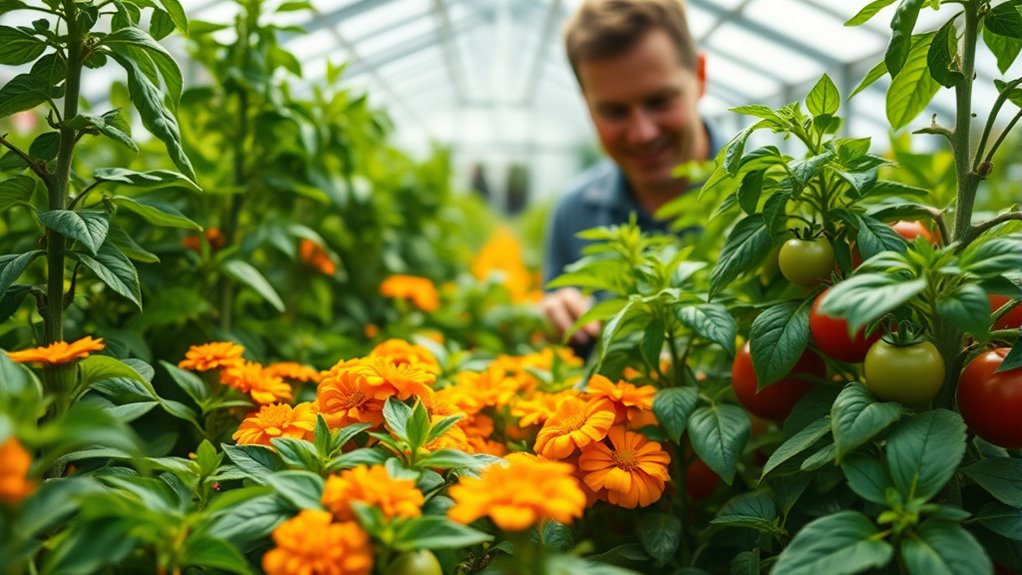
While you mightn't think of plants as allies in pest control, companion planting can be a powerful strategy against whiteflies. By increasing plant diversity in your greenhouse, you create a balanced environment that helps reduce pest populations. Incorporating herbs like basil and mint can repel whiteflies, while flowers like marigolds emit limonene, effectively deterring these pests. Nasturtiums serve as trap crops, drawing whiteflies away from your valuable plants. Additionally, planting calendulas early in the season can keep pests at bay before your main crops are established. Moreover, utilizing healthy snack options can improve overall plant health, making them more resilient to pest attacks. Practicing crop rotation can also enhance soil health and further reduce pest prevalence in your greenhouse. Furthermore, ensuring your plants receive essential nutrients can promote robust growth, thereby increasing their resistance to pest infestations. Additionally, maintaining emotional alignment within your gardening routine can enhance your connection to the plants, leading to more mindful care and attention to their needs.
Record Keeping and Pest Management Strategies
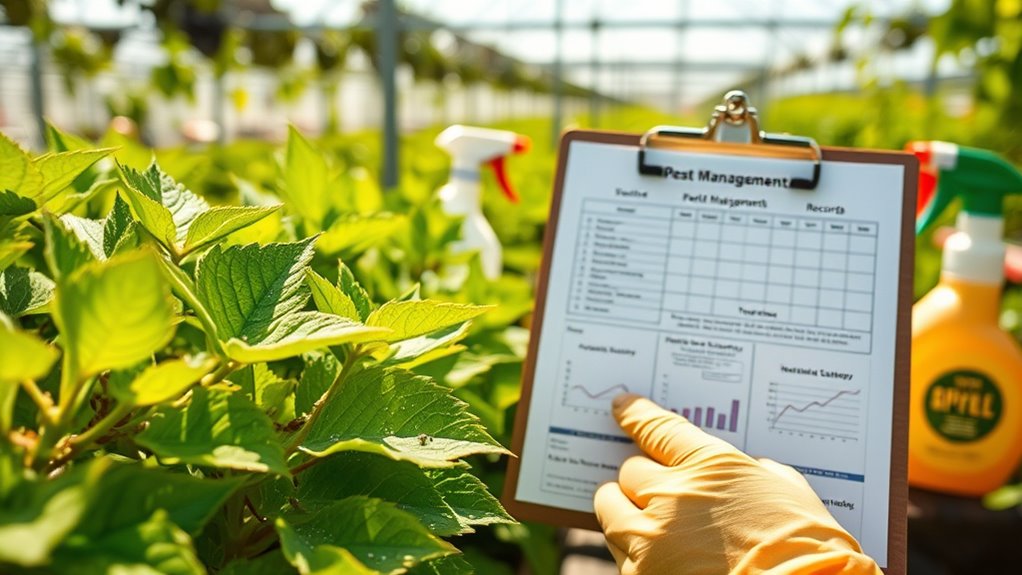
Effective record keeping is essential for managing whiteflies and other pests in your greenhouse. Use yellow sticky traps to monitor whitefly populations and keep detailed pest logs to track trends. Establish action thresholds based on your counts to guide timely interventions. Regularly inspect individual plants to catch pests early.
Incorporate physical strategies like insect screens and sticky traps, and consider hand-picking pests when infestations are low.
Biological controls, such as introducing beneficial insects, also help maintain balance. For chemical management, use targeted insecticides and rotate them to prevent resistance.
Frequently Asked Questions
How Do Whiteflies Affect Plant Health in Greenhouses?
Whiteflies can severely impact your plants' health in greenhouses. They feed on sap, weakening your plants and causing yellowing leaves.
As their populations grow, you might notice wilting and leaf drop. They also secrete honeydew, leading to sooty mold that reduces photosynthesis and affects the aesthetic appeal of your crops.
This can ultimately lead to lower yields and decreased marketability, making it essential to monitor and manage these pests effectively.
What Environmental Factors Attract Whiteflies to Greenhouses?
Whiteflies are attracted to greenhouses primarily due to warm temperatures, typically above 21°C (70°F), and high humidity, which stresses plants and creates favorable conditions for pests.
Low air flow allows them to colonize easily, while poor plant health and residues can harbor their nymphs.
Additionally, weed control is essential since weeds can serve as hosts.
Open doors and vents also increase the risk of these pests entering your greenhouse.
Can Whiteflies Transmit Plant Diseases?
Whiteflies can wreak havoc by transmitting devastating plant diseases. When they feed on infected plants, these tiny pests snatch up viruses and then inject them into healthy ones.
Imagine your prized tomatoes wilting away due to a whitefly's careless munching! These voracious pests don't just sap your plants' energy; they also carry a host of viruses that can lead to catastrophic crop losses.
What Is the Best Time to Release Beneficial Insects?
The best time to release beneficial insects is early in the morning or late in the afternoon. This timing helps avoid heat stress, ensuring the insects are more effective.
You should also consider the temperature, aiming for a range between 77–84°F (25–29°C), and maintain ideal humidity levels.
Before the release, make sure your greenhouse is pesticide-free for at least a week to create a favorable environment for the beneficial insects.
How Long Does a Whitefly Infestation Typically Last?
A whitefly infestation typically lasts as long as host plants are available, usually around three to four weeks under favorable conditions.
If you maintain ideal temperature and humidity levels, those pesky pests can thrive longer.
To shorten the duration, remove any infested plants, practice sanitation, and monitor your greenhouse regularly.
Conclusion
As you step into your greenhouse, imagine the vibrant plants thriving under a clear blue sky, untouched by pesky whiteflies. By implementing the strategies we've discussed, you can create a sanctuary where your plants flourish and pests are kept at bay. Embrace the harmony of nature, using organic and biological controls alongside cleanliness and careful planning. With diligence, you'll cultivate not just healthy plants, but a flourishing ecosystem, ensuring your greenhouse remains a pest-free paradise.
